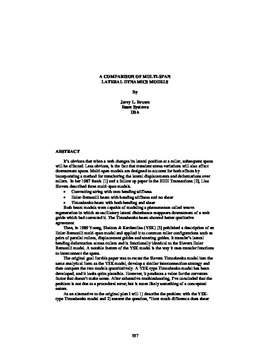| dc.contributor.author | Brown, Jerry L. | |
| dc.contributor.other | International Conference on Web Handling (2015) | |
| dc.date.accessioned | 2019-11-12T17:30:13Z | |
| dc.date.available | 2019-11-12T17:30:13Z | |
| dc.date.issued | 2015-06 | |
| dc.identifier | oksd_icwh_2015_brown2 | |
| dc.identifier.citation | Brown, J. L. (2015, June). A comparison of multi-span lateral dynamics models. Paper presented at the Thirteenth International Conference on Web Handling (IWEB), Stillwater, OK. | |
| dc.identifier.uri | https://hdl.handle.net/11244/322045 | |
| dc.description.abstract | It's obvious that when a web changes its lateral position at a roller, subsequent spans will be affected. Less obvious, is the fact that transient stress variations will also affect downstream spans. Multi-span models are designed to account for both effects by incorporating a method for transferring the lateral displacements and deformations over rollers. In her 1987 thesis [1] and a follow up paper in the IEEE Transactions [2], Lisa Sievers described three multi-span models. | |
| dc.description.abstract | Convecting string with zero bending stiffness | |
| dc.description.abstract | Euler-Bernoulli beam with bending stiffness and no shear | |
| dc.description.abstract | Timoshenko beam with both bending and shear | |
| dc.description.abstract | Both beam models were capable of modeling a phenomenon called weave regeneration in which an oscillatory lateral disturbance reappears downstream of a web guide which had corrected it. The Timoshenko beam showed better qualitative agreement. | |
| dc.description.abstract | Then, in 1989 Young, Shelton & Kardamilas (YSK) [3] published a description of an Euler-Bernoulli multi-span model and applied it to common roller configurations such as pairs of parallel rollers, displacement guides and steering guides. It transfers lateral bending deformation across rollers and is functionally identical to the Sievers Euler Bernoulli model. A notable feature of the YSK model is the way it uses transfer functions to interconnect the spans. | |
| dc.description.abstract | The original goal for this paper was to recast the Sievers Timoshenko model into the same analytical form as the YSK model, develop a similar interconnection strategy and then compare the two models quantitatively. A YSK-type Timoshenko model has been developed, and it looks quite plausible. However, it produces a value for the curvature factor that doesn't make sense. After exhaustive troubleshooting, I've concluded that the problem is not due to a procedural error; but is more likely something of a conceptual nature. | |
| dc.description.abstract | As an alternative to the original plan I will 1) describe the problem with the YSK-type Timoshenko model and 2) answer the question, "How much difference does shear make." with a quantitative comparison between the Euler-Bernoulli model of the YSK paper and a modified version of the Sievers Timoshenko model. A detailed derivation of the modified Sievers Timoshenko model is described in a companion paper [4] presented at this conference. | |
| dc.format | application/pdf | |
| dc.language | en_US | |
| dc.publisher | Oklahoma State University | |
| dc.rights | In the Oklahoma State University Library's institutional repository this paper is made available through the open access principles and the terms of agreement/consent between the author(s) and the publisher. The permission policy on the use, reproduction or distribution of the article falls under fair use for educational, scholarship, and research purposes. Contact Digital Resources and Discovery Services at lib-dls@okstate.edu or 405-744-9161 for further information. | |
| dc.title | Comparison of multi-span lateral dynamics models | |
| osu.filename | oksd_icwh_2015_brown2.pdf | |
| dc.type.genre | Conference proceedings | |
| dc.type.material | Text | |
